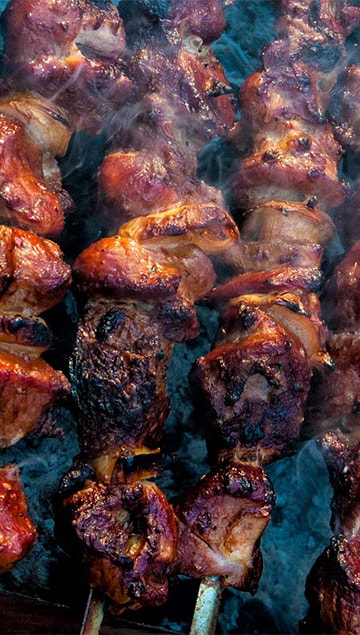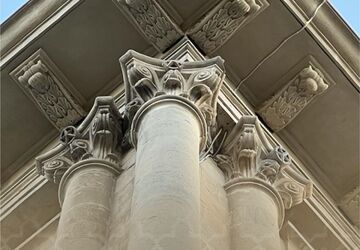Religious-Architectural Monuments of Icherisheher
The thing that distinguishes Baku from our other historical cities is the fact that at the beginning it appeared as a religious center, holy city. Religious-architectural monuments – mosques, tombs, as well as remains of churches and temples of fire attract attention within the area of Icheri Sheher fortification, which is not so large. Through history This area has been a hub for various religions throughout history. This city, known all over the world as the "Land of Fire," became famous for its temples of fire built on natural gas sources erupting from the earth. For this reason, Baku became a sacred religious center for fire worshippers coming from all over the world.
In the early VII century Islam religion started to spread in all cities of Azerbaijan, as well as in Baku, which was the influencial religious center for fire-worshipping. Traditionally, mosques were built on the foundation of ancient temples.
Historical- architectural monuments reflecting the religious culture of the Icheri Sheher had an impact on the social development of the people. Thus, mosques played an important role in the development of the science and education system in the Middle Ages. Religious monuments located in the area differ in the architectural structures. Jame (Jume) and quarter mosques.
Muhammad mosque is the most ancient mosque in Icherisheher. It was built by ustad al-rais Muhammad bin Abu Bakr in 1078/79 (471 hijri). Although the name of this monument is “Muhammad Mosque”, it is known as “Siniqqala” (broken tower). The mosque got its second name after the demolition of the top of the minaret as result of the bombardment of Baku by Russian troops in 1723.
This mosque is the monument of world value.
Palace mosque – the monument of the XV century located at the down courtyard of the Complex of Shirvanshahs’ Palace., The inscription engraved very delicately under the stalactite belt of the minaret runs: “This minaret was built by order of Sultan Khalilullah I, may Allah exalt the days of his government”. 845 hijri (or 1441-42 years).
This mosque is included into the Complex of Shirvanshahs’ Palace., which is considered the monument of world value.
Jame (Jume) mosque was built in the XIV century at the place of the ancient temple. In the XIX century the old building of the mosque was replaced with the new one by preserving its ancient minaret.
Jame mosques are the large mosques with minaret. On Fridays and on religious holidays the city dwellers gathered in the Jame mosque to make the public prayer. Different religious rituals were held in this mosque, as well.
The mosque is the monument of national value.
Beyler mosque was built by Zulfugar al-hadj, Hadji Baba and Hadji Javad, sons of Hadji Muhammad Hashim al-Bakuvi in 1894/95 (hidjri 1312). The name of well-known oil man Murtuza Mukhtarov is mentioned as a customer in one of the inscriptions engraved on the mosque. The monument, crowned with perfect minaret, was built in the place of a more ancient mosque and has successfully fitted into the curvilinear planning of the street.
The mosque is the monument of local value.
Quarter mosques – Icherisheher (Old city) consisted of several quarters. Mosques were usually built by the rich residents of the quarter. The quarter mosques have the similar architectural plan. They are the mosques with one praying room and cupola and without minaret. At medieval times the number of mosques depended on the largeness of the quarter. Therefore in one quarter there could be several small mosques.
Ashur mosque was built by master Najaf Ashur bin Ibrahim in 1171 on the foundation of an ancient temple of fire. The mosque has a large praying hall, a beautiful mehrab decorated with stalactites and pointed arched entrance.
Ashur mosque is the monument of national value.
Jinn mosque was built in the XIV century and named after “Jinn” chapter of Koran. This mosque of rectangular form has one praying room covered with pointed stone cupola and classic entrance – portal.
It is the monument of local significance.
Gileyli (Jomerd Geray) mosque was built in 1309. Although some changes were made in the structure of the mosque in the XIX century, that didn’t disrupt the compositional unity of the building. The mosque consists of a praying hall decorated with the ornamental mehrab and crowned with the pointed cupola and as well as small rooms in the corners.
It is the monument of national significance.
Hadji Bani mosque was built by the master-builder Hadji Bani in the XVI century. The central praying hall has the cupola and two large windows. During the repair-restoration works carried out in 1902, a praying room for women and corridor were added to the mosque without disrupting its traditional architectural style.
It is the monument of national significance.
Chin (Gazi Fezlullah bin Osman) Mosque was built by the will of Fezlullah Imam Osman Shirvani in 1375.
The folk etymology links the origin of the mosque’s name “Chin” to the fact that it was the holy place where wishes of people came true.
It is the monument of national significance.
Keykubad Mosque (remains) – The mosque built in the XIV century is included into the Complex of Shirvanshahs’ Palace. It was built by order of the Shirvanshah Keykubad. It was demolished during the March massacre in 1918. At present there are only mosque’s fragments, which were undergone the conservation works.
Madrasah-Mosque was built in the XII century and functioned as a madrasa-mosque till the late Middle Ages. Madrasa was an educational institution. The disciples (students) received here the degree of teacher (murshid). Special attention was given to the teaching of secular sciences in order to understand the essence of Islam religion. Thus, mathematics, geography, logic, literature and other sciences were taught in the same level as the theological sciences, such as fiqh (Sharia law), tafsir (interpretation of religion), word (religious beliefs). In the mid XVII century, there were more than 10 schools and 2 madrassas in Baku.
It is the monument of national significance.
İmam Gulu School-Mosque built in 1646, consists of a small quadratic praying hall and a rectangular room. At medieval times this mosque functioned as an elementary school.
It is the monument of national significance.
Mirza Ahmed Mosque . The small quarter mosque was built by Hadji Mirza Ahmed in 1347. This mosque of rectangular form consists of an entrance hall and a praying room.
It is the monument of local significance
Sayyid Murtuza Yahya Mosque was built in the early XVII century. It has quadratic architectural form with the central part crowned with the cupola. The monument has an impressive portal and a wooden entrance door. The mosque was named after the man, who had it built.
It is the monument of national significance.
Sheikh İbrahim (Khage Amirshah) Mosque was built by order of Hadji Amirshah bin Yakub in 818 hidjri (1415/16).
This monument of rectangular shape was covered with the pointed stone cupola. The architecture of the mosque combines the elements of European and local architectural styles.
It is the monument of national significance.
Taqiya built in the XIII century functioned mainly as a secondary school. It consists of one room quadratic shape. Here dervishes were clarified, and they fulfilled religious rituals alone or in group. Taqiya was also a shelter for the travelling strangers..
It is the monument of national significance.
Khidir Mosque was built in1301 over the temple of fire. The location of the mosque on a street staircase, and merlons placed along all perimeter of its upper walls give it special appearance, and reflect Oriental compositional styles.
It is the monument of national significance.
Molla Ahmed (Nasr ad-Din Geshtasib) Mosque. The monument was built in 1300 by financial means of Nasr ad-Din Geshtasib bin Hasan Hadjibaba.
This mosque of rectangular shape consists of a small praying hall, a plain mehrab and two windows added later.
It is the monument of national significance.
Khanegah Complex (Tekke) was usually located on caravan-trade roads. Khanegah Complex included caravanserai, tomb, taqiya, mosque, ovdan, hamam and other religious and social buildings. Sheikhs, Caliphs, craftsmen, murids and dervishes, complex managers, guests and other visitors were in the Khanegah.
As a result of occupation of Azerbaijan by Russians in 1806, orthodox churches were built in this area. The church built in 1815 was named after the holy Nikolaus Mirlikiyskiy. After a while, the church was demolished by the Tsarist Russia and a new one was built on the spot. This church was named after Bartholomew, one of the apostles of Jesus Christ.
The church built next to the Shamakhi gate in March 1850 was again called the "Miracle Creator Nikolaus ". These monuments were destroyed by the Soviet regime under the influence of Atheist ideology in 1936. At present the remains of the church are preserved.











